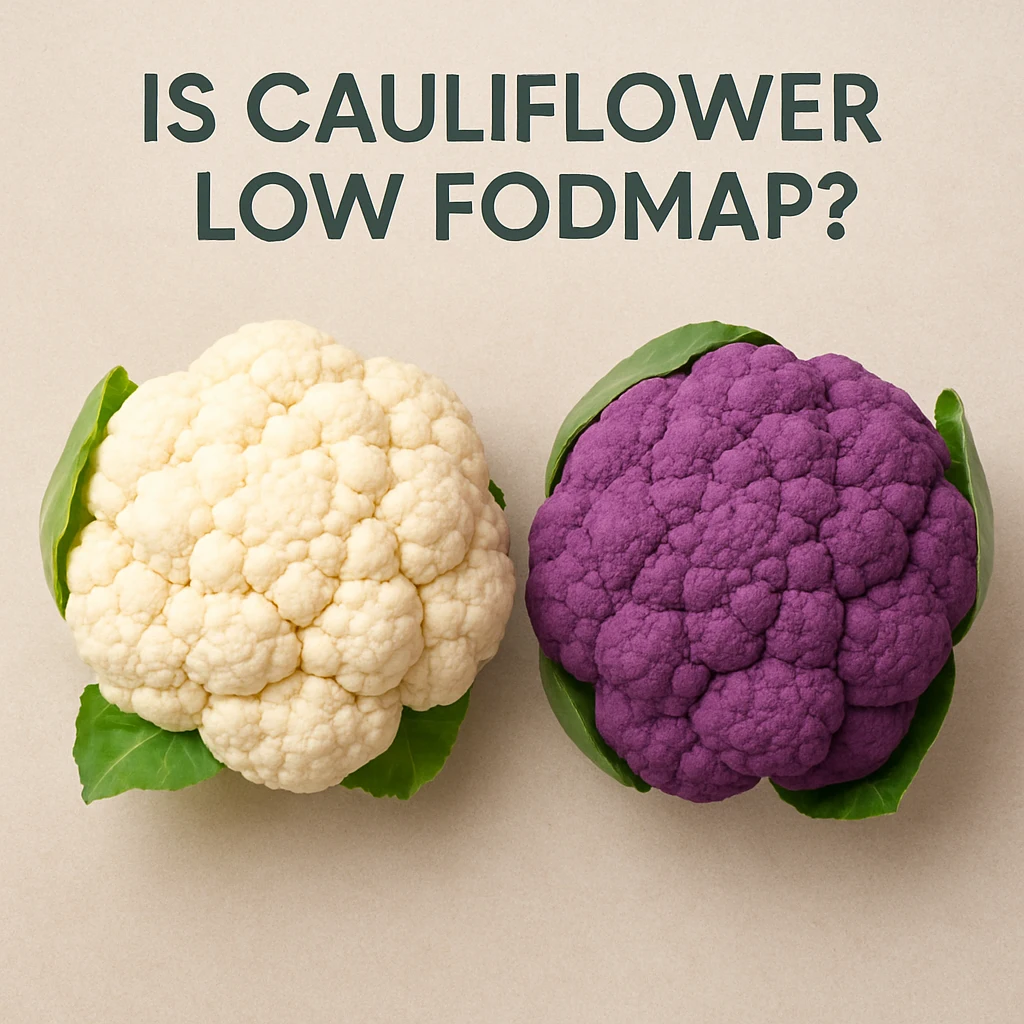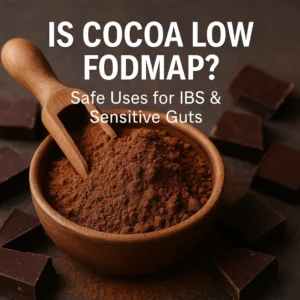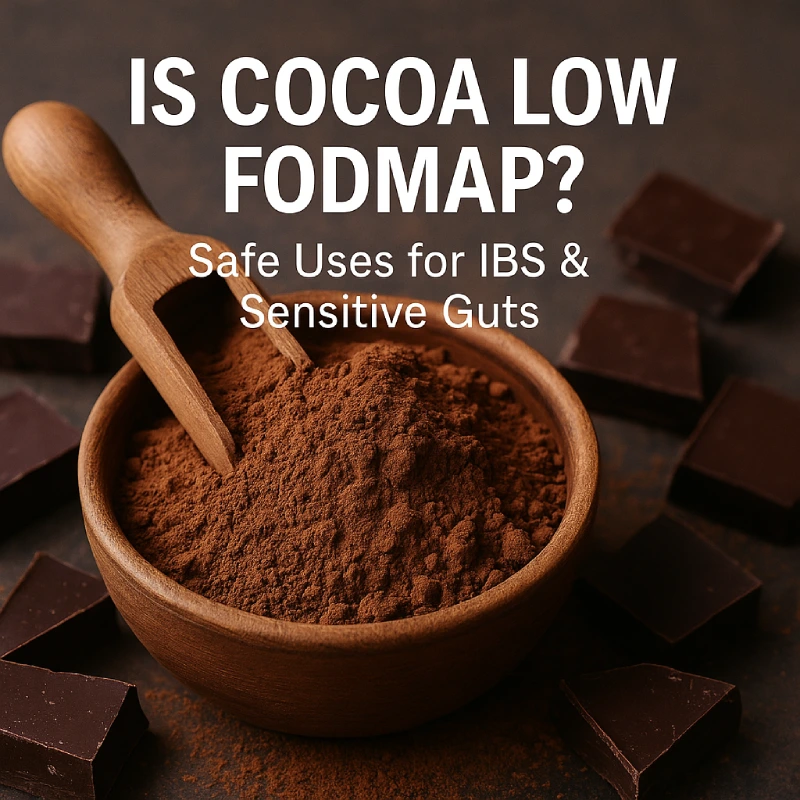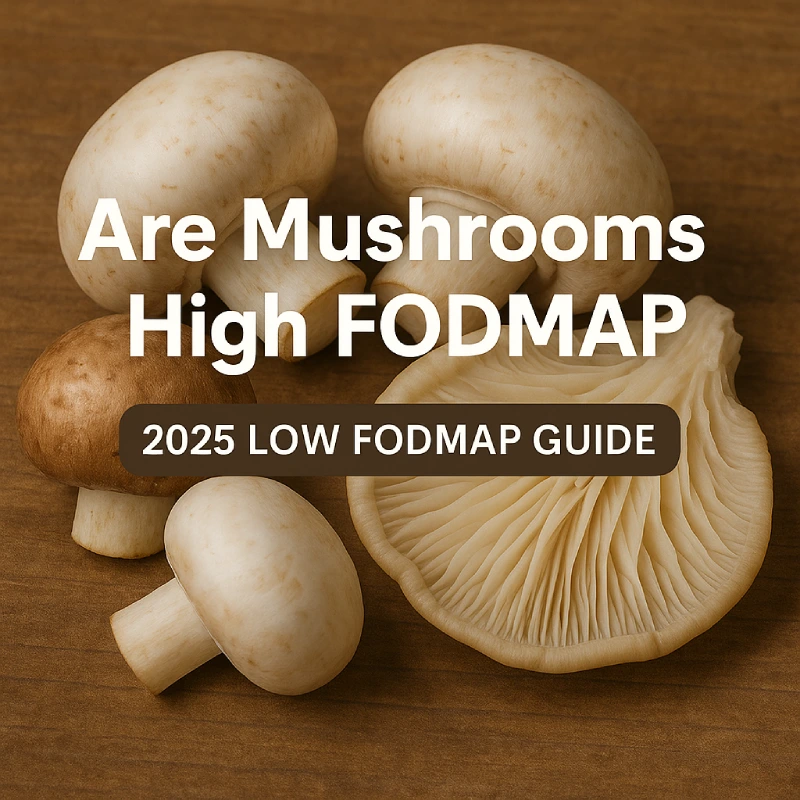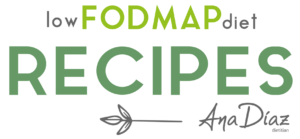Many people following a low FODMAP approach wonder: Is cauliflower low FODMAP? With recent research updates, the answer is hopeful, but it depends entirely on variety, portion size, and your personal tolerance. In this guide, we’ll walk through the science, what’s new from Monash University, and practical ways you can enjoy cauliflower without digestive stress.
Table of Contents
What Does “Low FODMAP” Actually Mean?
Understanding FODMAPs and Digestive Comfort
FODMAPs (Fermentable Oligo-, Di-, Mono-saccharides, And Polyols) are naturally occurring carbohydrates. They are found in many everyday foods like apples, onions, garlic, legumes, and certain grains.
For most people, FODMAPs don’t cause any noticeable issue. But for those with Irritable Bowel Syndrome (IBS) or a sensitive gut, they can ferment in the large intestine, drawing water into the bowel and producing gas. The result? Bloating, pain, diarrhoea, or constipation.
Learning to recognise which foods are low or high in FODMAPs can make a huge difference to your daily comfort.
The Low-FODMAP Diet’s Three Phases
The low FODMAP diet was created by Monash University researchers in Australia and has now been adopted globally. It’s not about eliminating foods forever but following a structured approach:
- Restriction Phase (2–6 weeks): Temporarily limiting high-FODMAP foods to calm symptoms.
- Reintroduction Phase: Testing one group of FODMAPs at a time to understand your tolerance.
- Personalisation Phase: Re-building a varied diet with foods you tolerate, avoiding unnecessary restriction.
This approach allows you to manage symptoms while still enjoying a diverse, nourishing diet.
Is Cauliflower Low FODMAP? The Most Up-to-Date Insight
White Cauliflower and Mannitol
For years, cauliflower was considered firmly “off-limits” in a low FODMAP diet. The reason lies in its mannitol content. Mannitol is a type of polyol (sugar alcohol) that is poorly absorbed in the gut.
A standard serving of white cauliflower (around 75 g (¾ cup)) is still classified as high in mannitol, according to both Monash University and FODMAP Friendly. This means that for most people with IBS, even modest portions of white cauliflower may trigger symptoms.
Purple Cauliflower’s Gentler Side
The exciting update comes from recent Monash testing: purple cauliflower is low FODMAP at 75 g servings.
At 75 g, purple cauliflower remains safe. At around 112 g (1¼ cups), it moves into the “moderate FODMAP” range due to fructose, but importantly, it doesn’t contain mannitol. Even larger serves (150 g) show fructose as the only concern. This makes purple cauliflower a gentler, more forgiving option for people wanting to include this vegetable without discomfort.
Tiny Servings of White Cauliflower; A Possible Option
While Monash hasn’t published data on very small portions of white cauliflower, FODMAP Friendly suggests that a tiny serve of about 9 g (just a spoonful of florets) may be low FODMAP. While this is hardly enough to form a dish, it may be tolerated if used in mixed recipes.
This demonstrates the nuance of FODMAP science: portion size matters as much as the food itself.
Why the Confusion? Outdated Lists and Evolving Science
Out-of-Date Information
If you’ve searched online, you’ve probably found conflicting answers. Some lists mark cauliflower as always high FODMAP, while others celebrate it as safe. This confusion arises because research is constantly evolving. What was “true” five years ago may no longer reflect today’s lab results.
That’s why the Monash FODMAP Diet App is such a valuable tool; it updates as soon as new foods are tested, keeping you informed.
Portion Size Makes a World of Difference
FODMAP levels aren’t linear. Doubling a portion doesn’t just double the FODMAPs; it can push the food into a whole new category. For example:
- 75 g of purple cauliflower = low FODMAP
- 112 g = moderate FODMAP
- 150 g = high FODMAP
This is why measuring portions carefully during the elimination and reintroduction phases is crucial. Eyeballing amounts often leads to unintentional “over-serves” that can cause symptoms.
Other Gut Triggers Beyond FODMAPs
It’s also important to remember that FODMAPs aren’t the only factor influencing digestion. Cruciferous vegetables like cauliflower contain natural compounds (such as sulphur compounds) that can cause gas in some people, even if the food is technically low FODMAP.
So if you still feel bloated after a small portion of cauliflower, it may not be the FODMAPs; it could simply be your gut’s reaction to its fibrous nature.
Gentle Ways to Include Cauliflower Comfortably
Start Small and Listen to Your Gut
If you’re keen to reintroduce cauliflower, begin with purple cauliflower at a 75 g portion. Keep a simple food and symptom diary to track how your body responds.
For white cauliflower, start with only a teaspoon or two in mixed dishes. If tolerated, you might slowly increase, but proceed gently.
Cooking Methods That Help
Raw cauliflower is much harder to digest. Lightly steaming, roasting, or sautéing can break down some fibres, making it gentler on your gut. Using garlic-infused oil instead of whole garlic is another helpful way to flavour cauliflower dishes without adding extra FODMAPs.
Recipe Inspiration for You
Here are three easy, comforting ideas:
- Cauliflower Rice (Purple Variety): A lighter substitute for grain rice. Pulse florets in a processor, then sauté with olive oil, herbs, and a squeeze of lemon.
- Golden Roasted Cauliflower: Roast ¾ cup florets with turmeric, cumin, and olive oil until golden brown. Pair with a protein for a nourishing meal.
- Creamy Cauliflower Mash: Steam ¾ cup florets, then blend with lactose-free milk or cream cheese. A soothing side dish for fish or chicken.
These recipes allow you to enjoy the texture and flavour of cauliflower, without risking a flare-up.
Broader Health Benefits: Why Cauliflower Still Matters
Cauliflower is often described as a “nutritional powerhouse”. Even if you can only tolerate small amounts, it offers valuable benefits:
- Rich in vitamin C: boosting immunity and supporting skin health.
- Contains vitamin K: important for bone health and blood clotting.
- Good source of fibre: which supports a healthy gut microbiome.
- Packed with antioxidants: compounds like sulforaphane may protect against inflammation and chronic diseases.
Interestingly, cauliflower can also be part of weight-management strategies because it’s filling yet low in calories.
How to Build Confidence with Cauliflower Again
For many people with IBS, cauliflower carries fear because of past symptoms. It’s normal to feel hesitant about reintroducing it. Here’s a gentle step-by-step approach:
- Check your symptom baseline first: Only test cauliflower when your gut feels relatively calm.
- Start with purple cauliflower: It has a safer FODMAP profile at moderate serves.
- Measure portions carefully: Use a scale for accuracy during the testing phase.
- Keep a diary: Record what you ate, how much, and how you felt 4–24 hours afterwards.
- Work with a dietitian if possible: Professional support makes reintroduction less stressful and more reliable.
This process isn’t about rushing; it’s about creating a diet that feels both nourishing and safe.
FAQs about Cauliflower and the Low FODMAP Diet
Is cauliflower always high FODMAP?
Not always. White cauliflower is generally high due to mannitol, but purple cauliflower is low FODMAP at 75 g serves.
Can I eat small amounts of white cauliflower?
Possibly. Tiny amounts (around 9 g) may be tolerated, though Monash hasn’t confirmed this yet.
What if even purple cauliflower causes symptoms?
Every gut is unique. You may react to compounds beyond FODMAPs. In that case, reduce the portion or choose another vegetable.
How do I stay updated on FODMAP info?
The Monash University FODMAP Diet App is the most reliable, up-to-date resource available. And if you’d like regular, simple tips and the latest FODMAP updates delivered straight to your inbox, don’t forget to join our newsletter; you’ll always feel supported and informed.
What are good alternatives if I can’t tolerate cauliflower?
Try zucchini, broccoli heads (not stalks), or eggplant in place of cauliflower. These can mimic similar textures in cooking and are often easier to digest.
Gentle Call-to-Action
If you’d like me to share more soothing, gut-friendly recipes using vegetables like zucchini, pumpkin, or eggplant, or if you’d like me to create a week’s worth of low FODMAP meal plans, I’d be delighted to guide you. Together, we can make your plate colourful, nourishing, and truly comforting. Click here to contact for any questions you would like to ask.

